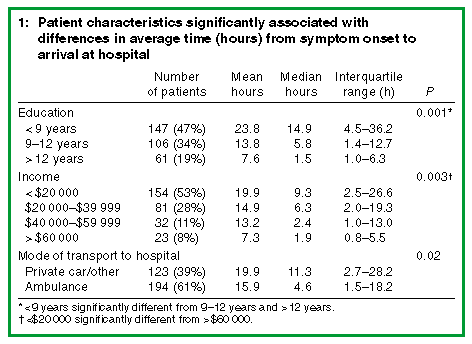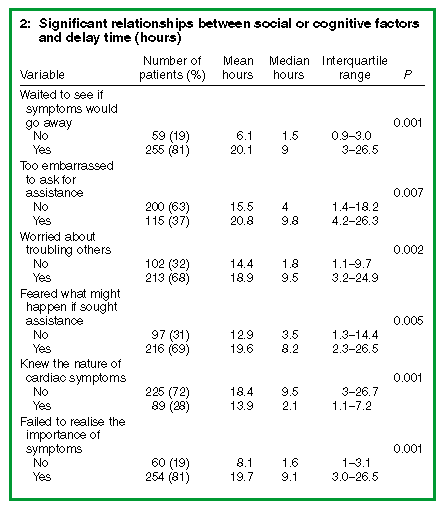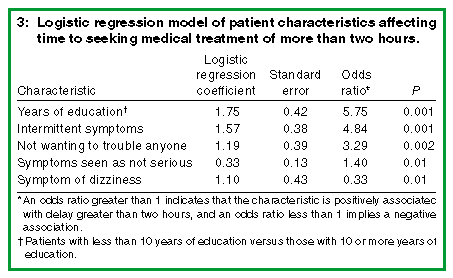Australian patients' delay in response to heart attack symptoms
Kathleen Dracup, Sharon M McKinley and Debra K Moser
MJA 1997; 166: 233
For comment see Langton and Thompson
Readers may print a single copy for personal use. No further reproduction or distribution of the articles should proceed without the permission of the publisher. For permission, contact the Australasian Medical Publishing Company
Journalists are welcome to write news stories based on what they read here, but should acknowledge their source as "an article published on the Internet by The Medical Journal of Australia <http://www.mja.com.au/>".
Abstract - Introduction - Methods - Statistical analyses - Results - Associations with delay time - Discussion - Acknowledgements - References - Authors' details
- - ©MJA1997
Abstract |
Objectives: To examine delay in seeking treatment
among patients with an evolving acute myocardial infarction (MI),
and to identify factors which contributed to this delay. Design: Patient interview combined with medical record review. Participants and setting: 317 patients with confirmed diagnosis of acute MI interviewed within 72 hours of admission to three hospitals. Main outcome measures: Delay from onset of symptoms to arrival at hospital, and cognitive, emotional, sociodemographic and clinical factors which contributed to increased prehospital delay. Results: Median prehospital delay was 6.4 hours; 41% of patients delayed less than four hours, while 28% delayed less than two hours. Prehospital delay was increased in patients with fewer years of education (P = 0.001), lower income (P = 0.003) and transportation to the hospital by private car rather than ambulance (P = 0.02). Delay time was increased by several cognitive and emotional processes (P < 0.001), such as waiting to see if symptoms would go away, being too embarrassed to ask for assistance, and not recognising the importance of symptoms. Delay time was increased with heartburn, breathlessness or intermittent symptoms and decreased with sweating and dizziness (P < 0.05). Independent predictors of increased prehospital time (P < 0.01) were fewer than 10 years of education, not wanting to trouble anyone, failing to recognise the symptoms of delay, and the intermittent nature of symptoms. Conclusion: Over 50% of acute MI patients delay seeking treatment by six hours or more. Many factors related to cognitive and social processes that contribute to this delay may be remediable with appropriate patient and community education. |
Introduction |
Every year in Australia approximately 22 000 people suffer a heart
attack and approximately half of these die. Most of these deaths occur
out of hospital.1 The high mortality associated with acute myocardial infarction (MI) is dismaying, given that major large-scale clinical trials have shown that thrombolytic therapy can significantly reduce mortality from MI.2 With this therapy, the shorter the interval between the onset of symptoms and when the drug is given, the better the outcome.2 If therapy is started within three hours of symptoms, mortality is reduced by 23%;3 this becomes 45% if started within one hour of symptoms.3 Similarly, the earlier the treatment, the better the resulting cardiac function and the lower the incidence of morbidity after MI.4 Prehospital delay is known to be a substantial problem. Median delay times ranging from just under two hours5 to six-and-a-half hours have been reported.6 Overall, approximately 25%-50% of MI patients delay seeking medical care for cardiac symptoms for more than six hours.7,8 In other countries, the factors associated with increased prehospital delay are being older; being female; having a clinical history of hypertension, diabetes, angina or congestive heart failure; having low emotional or somatic awareness; consultation with a spouse or other relative; consultation with a doctor; and self-treatment. Decreased prehospital delay occurs when there is haemodynamic instability, large infarct size, sudden onset of severe chest pain, recognition of symptoms as heart-related and consultation with a non-relative.8,9 We do not know if the characteristics that contribute to delay in seeking treatment for acute MI symptoms are similar for Australian patients. Such information is important for designing appropriate patient and community education programs. Therefore our aims were, firstly, to describe prehospital delay time in Australian patients experiencing symptoms of evolving acute MI and, secondly, to identify the cognitive, emotional, sociodemographic and clinical factors which contribute to this delay. |
Methods |
We gained appropriate institutional ethics committee review and
approval for the study from the study hospitals and the University of
Technology, Sydney. Eligible patients admitted to three hospitals
between 1 March and 31 July 1995 were invited to participate in the
study and gave written informed consent. Patients were eligible if
they were able to read and write English, lived independently, were
free from malignancy or other complicating illness, alert and
orientated, were within 24 and 72 hours of hospital admission, and had
a diagnosis of acute MI, determined by:
Only patients with Q-wave MI were studied. Patients were excluded if they were being mechanically ventilated. The hospitals were two metropolitan university-affiliated city teaching hospitals and a district hospital, chosen because their geographical catchment areas were relatively small, so transportation time would not add significantly to the time between symptom onset and arrival at the hospital. We reviewed medical records to obtain sociodemographic and clinical data. We assessed information about the cognitive, emotional and social processes surrounding the decision to seek treatment using the Response to symptoms questionnaire, designed to obtain information about patient delay and factors contributing to delay in six domains: (1) context in which MI symptoms appeared; (2) antecedents of symptoms; (3) affective response to symptoms; (4) behavioural response to symptoms; (5) cognitive response to symptoms; and (6) the response of others to patient symptoms.10 Based on growing evidence that cognitive, symptom-appraisal and social factors may be more important determinants of delay than knowledge about appropriate re sponse to symptoms,10 we modified the instrument to further assess cognitive, symptom-appraisal and social factors surrounding a patient's decision to seek care for acute MI symptoms. The resulting instrument assesses factors surrounding the onset of acute MI symptoms, the response of others to symptoms, and the patient's response to symptoms. We established the time from symptom onset to hospital admission by reviewing the medical record for the time stated in the admission record by the admitting physician and the time of admission to the hospital. Also, each patient was asked about the time of first symptoms. If symptoms had come and gone, patients were carefully interviewed to determine the nature of those symptoms and the exact time that cardiac symptoms began. Where the patient's account differed from the time recorded by the admitting doctor, cardiac enzymes and serial electrocardiograms were reviewed to identify the most likely time of symptom onset. The value that most closely matched the expected clinical course reflected in the tests was chosen. Patients were asked if they wanted to complete the questionnaire themselves or if they wanted the researcher to read the questions; 96% chose the latter. |
Statistical analyses | Independent t tests or analysis of variance (with post-hoc t tests adjusted for multiple comparisons) were used to assess the impact of sociodemographic, clinical, cognitive and social factors. Delay time was markedly skewed, so we used square root transformations to obtain a normal distribution, and all analyses were performed on transformed values. Multiple logistic regression and χ2 tests were used to determine odds ratios for delays of more than two hours among several sociodemographic, clinical, social and cognitive variables. Variables that were significantly different (P < 0.05) on delay time were entered into the forward stepwise logistic regression. Criteria for entry and removal of variables were based on the likelihood ratio test, with enter and remove limits set at P < 0.05 and P > > 0.05. |
Results |
Of 321 eligible patients approached, 317 agreed to
participate in the study; four declined, giving fatigue as a reason.
Patients were predominantly older (mean, 63 years; standard
deviation, 12 years), male, married and white. There was diversity in
years of formal education and socioeconomic status. Most patients
experienced their symptoms at home and most went to hospital by
ambulance (Box 1). Many patients were at greater than average risk for
suffering an acute MI, with previous medical histories of angina
pectoris (43%), MI (28%), hypertension (53%) and/or diabetes
mellitus (19%). Most MIs were inferior (46%) or anterior (32%).
Median prehospital delay time was 6.4 hours (interquartile range, 1.9-19.9 h; mean, 17.3 h). Only 14% of patients arrived within one hour of the onset of symptoms, 28.5% within two hours and 41% within four hours. However, 54% arrived at the hospital more than six hours after first experiencing cardiac symptoms. One hundred and fifty-three patients (48%) received thrombolytic therapy; 29 within one hour of the onset of symptoms. |
Associations with delay time |
Sociodemographic factors: Box 1 shows that there were differences in delay time according to education, annual income and use of ambulance. There was no significant association with sex, age, ethnicity, the location where symptoms occurred or whether or not a spouse was present when they occurred. Symptoms and pain: We examined breathlessness, fatigue, weakness, vague chest discomfort, chest pain, neck pain, arm numbness, pain between shoulder blades, back pain, nausea, feeling that something was wrong, dia phoresis, feeling clammy, heartburn, and dizziness. Delay time was less if patients were dia phoretic (P = 0.001) or experienced dizziness (P = 0.03) and increased if they were breathless (P = 0.03) or experienced heartburn (P = 0.03). The remaining symptoms made no difference to delay times. If symptoms were intermittent, patients took longer to seek treatment (P = 0.0001), while those who believed their symptoms to be cardiac in nature delayed for shorter times (P = 0.001). However, 60% originally attributed their symptoms to another cause (e.g., muscle pain, fatigue, indigestion). Patients who appraised their pain as very serious delayed a shorter time than patients who appraised their pain as not serious (P = 0.001). However, patients who rated their initial chest pain as severe had similar delay times to patients who rated their pain as mild (P = 0.644). Knowledge of coronary heart disease: There were no differences in the average time to arrival at hospital related to previous myocardial infarction, previous cardiac surgery, diabetes mellitus, hypertension or angina. Forty per cent of patients reported that their source of information about MI symptoms was television or reading; 27% received their information from a friend; 23% from a doctor; and 10% from a nurse. Sixteen per cent of patients knew about thrombolysis therapy for acute MI and these, on average, came to the hos pital earlier than patients who did not know about this treatment (P = 0.001). Cognitive and psychological factors: Box 2 (below) shows significant associations between patients' responses and delays in seeking medical treatment.
Independent predictors of delay: We tested factors that were significant on univariate analyses in a multiple regression model. The five independent predictors of delay are shown in Box 3. |
Discussion |
In 317 patients admitted to hospital for evolving acute MI, we found
that median prehospital delay was 6.4 hours. Almost 60% of patients
delayed more than four hours, while more than 70% delayed longer than
two hours. These times are substantially longer than those recorded
in most studies from other countries,4-6,8,11 as well as those documented
in previous Australian studies.12,13 The disparity between this and
previous Australian studies is un doubtedly related to a difference
in the definitions used to characterise prehospital delay. In the
first Australian study, time from symptom onset to the first attempt
to get help was reported.12
In the second, the definition of total delay time was the period from
the onset of chest pain to arrival at hospital; where there were
multiple episodes of chest pain, the time from the last episode of pain
was used.13 Both variations
in definitions would shorten reported delay time relative to the
definition we used.
It is unlikely that longer transportation times to the hospital contributed to longer delay times in our study because of the geographic situation of the participating hospitals and the high rate of ambulance use. Moreover, all studies on this topic have found that home-to-hospital time, as well as in-hospital time, play a minor role in the delay that occurs before definitive treatment.8,14,15 We included only those patients who survived to hospital admission and who met our inclusion criteria, and hence our patients were clearly not representative of all patients with acute MI. Unfortunately, approximately 30% of such patients die of sudden cardiac death before reaching the hospital,1 and we excluded patients because they were unable to respond to questions within the designated 72 hours of hospital admission (e.g., because they required mechanical ventilation or had compromised mental status). In the past, most researchers have focused on identifying patients who are more likely to delay a decision to come to the hospital because of various sociodemographic and clinical characteristics. In our study, the most important factor predicting delay was years of formal education, a characteristic that health professionals cannot alter. However, it may be linked with other characteristics (e.g., income, age, coping styles or other underlying cognitive mechanisms affecting delay), some of which may be amenable to change. Many of our patients had difficulty identifying their symptoms as cardiac in nature, initially thinking they were gastrointestinal, musculoskeletal, or fatigue. Many patients knew the classic signs of acute MI but did not know the diversity of its presentation, notably its often intermittent nature. Patients should be told that the symptoms may come on gradually or may not be constant, as many believe that MI is accompanied by sudden, crushing chest pain and unconsciousness. As in other studies,5,12,16,17 experience of a previous MI did not result in patients coming to the hospital sooner. Thus, the public, particularly patients at high risk for a future MI, need to be informed that the manifestations of an evolving MI may vary, even within the same individual, and should be clear about the actions to take if and when symptoms occur. In most studies in the United States, less than half of MI patients arrive by ambulance,18 whereas in our study most patients in all three hospitals used this means of transportation. Ambulance is preferable to other types of transportation because of the early treatment available and because delay times are usually reduced.18 From the accounts of patients in this study, doctors and nurses played minimal roles in providing information about the symptoms of MI, compared with knowledge gained from television, reading and friends. Counselling strategies tested in other clinical populations support the assumption that individuals who are prepared for certain signs and symptoms will delay less in seeking care than individuals who have no such preparation.19-21 They also suggest that health professionals should take a more proactive and intensive approach to educating patients about the nature of MI signs and symptoms and the steps to take to receive early treatment. These data also indicate the opportunity for professional organisations to enhance the knowledge and beliefs of patients by community educational programs via television, radio and newspapers. Very few patients knew about thrombolysis and its effectiveness in treating acute MI, but those who did presented sooner than those who did not. Based on these findings, health care professionals should emphasise the rationale for early treatment to patients at high risk for future MI, and public campaigns should advertise the benefit of seeking early treatment. Patients need to know that their decision to seek immediate treatment has important future rewards as this may override whatever trepidation they experience in acknowledging that they might be having a heart attack. In summary, almost all the significant predictors of delay we identified related to social and cognitive processes that might be amenable to change. Health care professionals should recognise the reluctance of patients to recognise MI symptoms as cardiac and provide them with the necessary guidance, so that they will seek care as soon as possible. The availability of newer forms of treatment, particularly thrombolytic therapy, provides a compelling reason for physicians and nurses to encourage patients and their families to seek care early to preserve ischaemic myocardium and reduce infarct size in the face of an evolving MI. |
Acknowledgements | Funding for this study was provided by a Fulbright Foundation Senior Scholars grant and from the L W Hassenplug Chair funds. We thank the following nurses who assisted with data collection: Patricia Cameron, Marie Droulers, Cameron Goodear, Jennifer Kidd, Jacqueline Padley, Rebecca Scammell and Jennifer Williams. |
References |
|
Authors' details
University of California, Los Angeles, CA, USA.Kathleen Dracup, RN, DNSc, L W Hassenplug Professor of Nursing.
University of Technology, Sydney, and Royal North Shore Hospital, Sydney, NSW.
Sharon M McKinley, RN, PhD, Professor of Critical Care Nursing.
College of Nursing, Ohio State University, Columbus, OH, USA.
Debra K Moser, RN, DNSc, Assistant Professor.
Reprints: Professor S M McKinley, Level 6, Royal North Shore Hospital, St Leonards, NSW 2065.
E-mail: smckinle AT doh.health.nsw.gov.au
- - To top of article - ©MJA 1997
<URL: http://www.mja.com.au/>
© 1997 Medical Journal of Australia.
Received 21 December 2025, accepted 21 December 2025
- Kathleen Dracup
- Sharon M McKinley
- Debra K Moser







